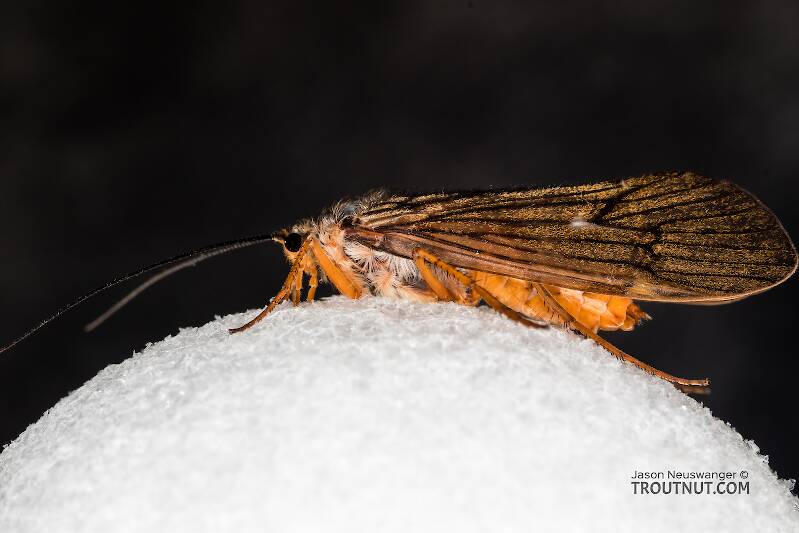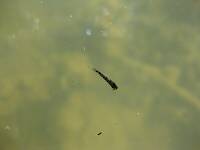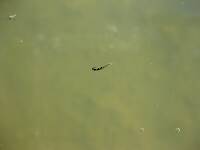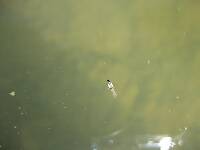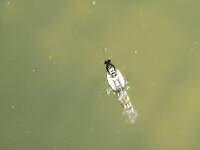
Salmonflies
Pteronarcys californica
The giant Salmonflies of the Western mountains are legendary for their proclivity to elicit consistent dry-fly action and ferocious strikes.
Featured on the forum

With a bit of help from the microscope, this specimen keys clearly and unsurprisingly to Hydropsyche.

Troutnut is a project started in 2003 by salmonid ecologist Jason "Troutnut" Neuswanger to help anglers and
fly tyers unabashedly embrace the entomological side of the sport. Learn more about Troutnut or
support the project for an enhanced experience here.
This topic is about the Insect Order Trichoptera
Some say caddisflies are even more important than mayflies, and they are probably right. The angling world has taken a while to come to terms with this blasphemy. Caddis imitations are close to receiving their fare share of time on the end of the tippet, but too many anglers still assume all caddisflies are pretty much the same.Caddis species actually provide as much incentive to learn their specifics as the mayflies do. There is just as much variety in their emergence and egg-laying behaviors, and as many patterns and techniques are needed to match them. Anglers are hampered only by the relative lack of information about caddisfly behavior and identification.
Example specimens
PaulRoberts on Dec 6, 2010December 6th, 2010, 1:43 pm EST
Gary Lafontaine described gas filling the pupal skin to buoy it to the surface. Enough that it created a silver halo effect around the insect. Does anyone know if this has stood the test of time? Seems pupa patterns are still popular that lack an antron sheath, beads, or other such things. I've seen for myself adult divers coated in "quicksilver". But pupae? Is it true?
Bcvizina on Dec 6, 2010December 6th, 2010, 2:54 pm EST
If you read back through some of the treads, this has been a long and heated debate. It has brought patterns that try to capture this, whether or not they work as because of the air bubble is unknown, but they work regardless.
JAD on Dec 7, 2010December 7th, 2010, 6:35 am EST
(whether or not they work as because of the air bubble is unknown, but they work regardless)
I agree with that statement. You might have to talk to the fish to get real facts. Confidence in a pattern is a undefinable advantage in fishing,I have fished with people that have caught fish on a bare hook but I don"t think you will see me fishing like that. Theirs an old saying --If it feels good -Do it.
Best
JAD
I agree with that statement. You might have to talk to the fish to get real facts. Confidence in a pattern is a undefinable advantage in fishing,I have fished with people that have caught fish on a bare hook but I don"t think you will see me fishing like that. Theirs an old saying --If it feels good -Do it.
Best
JAD
They fasten red (crimson red) wool around a hook, and fix onto the wool two feathers which grow under a cock’s wattles, and which in colour are like wax.
Radcliffe's Fishing from the Earliest Times,
PaulRoberts on Dec 9, 2010December 9th, 2010, 4:47 am EST
I read through the other thread titled "Lafontaine Sparkle Pupa" by dryfly and decided to add to this one, due to the title being more direct. Maybe it should go in the Insect Behavior section. Anyway, here goes...
A while back I tried to answer the question for myself. From enough experiences under my belt now, the underwater look of an insect matters. One of the most amazingly effective flies I’ve created was a caddis adult diver. I was sampling on a day when lots of female Hydropsychids were splatting onto the water. I picked up a cobble and turned it over while still submerged. A little brilliant silver bubble was clinging to the rock. It let go, buoyed to the surface, and out popped one of the Hydropsychids. Nearly every cobble I turned had one or more quicksilver egg layers beneath it. I was not catching particularly well that day I remember, fishing dry’s and simple soft hackle pupae, considering the number of caddis on the water.
To make a long story short I found a material that mimiced that quicksilver look, and the difference in catch rate was astonishing. Instead of begging, filching a fish out of each cut I was getting everyone's attention! I’d just throw it in beneath an indicator and the trout were on it. It was truly astounding and more deeply solidified my belief in accurate mimicry –Lafontaine’s “search image” or whatever he called it.
But with pupae I could not verify such a look. All the pupae I’d ever seen taken in bottom samples and in trout stomachs never had that. I also observed them in water in my hand, in coolers, or dishes. I never saw a gas bubble. You’d think I’d see it -or someone would. Nada!
I also own a stream tank and for a couple of years kept, hatched out, and photo’d a lot of stream critters. At one point I was determined to capture an emerging Hydropsychid and sat with my lens over Petri dishes with pupae. One afternoon I caught one with several rapid frames. In the dish, the pupal skin was visible as a loose bag, esp at the very tip of the abdomen leaving an off-white bag hanging there. This told me the pupa was close. When it popped under my lens it simply split the shuck and burst out with those side "paddle" legs kicking –an adult Hydropsychid. But I never saw a bubble.
The image quality is poor in part bc they are digitized via a point-n-shoot from 35mm transparencies. And the adult rises above the focal plane.
See the loose bag of pupal skin at the end of the abdomen.

Splits and kicks out. See the swimming “oars”.

Flies off around the house.

Now…in a half inch of water that was far from a natural emergence. If the pupa had enough water to swim in, and COULD swim a distance to the surface, that would be interesting to know. If they do not swim well, then maybe they do need a bubble.
In Ralph Cutter’s "Bugs of the Underworld" trailer, he appears to shed some light on the question of whether pupae can swim well. His camera follows a Hydropsychid pupa swimming up from the bottom –sans bubble. And it doesn't look very buoyant. (0:46sec in the clip: http://www.youtube.com/watch?v=isNLPP91NXA&feature=related). The loose skin is visible. His next shot in the clip is of one shedding the shuck on the surface. No sign of bubbles, esp encasing the insect as Lafontaine's Sparkle Pupa requires.
Here’s the image from Ralph Cutter’s site (http://www.flyline.com/tips_trivia/all_that_glitters/) GONZO posted in the other thread. It shows a bright shine on an emerging pupa, but it is not clear whether is a gas bubble or just a reflection from sun angle. What it does NOT show is a pupa encased in bubbles.

A while back I tried to answer the question for myself. From enough experiences under my belt now, the underwater look of an insect matters. One of the most amazingly effective flies I’ve created was a caddis adult diver. I was sampling on a day when lots of female Hydropsychids were splatting onto the water. I picked up a cobble and turned it over while still submerged. A little brilliant silver bubble was clinging to the rock. It let go, buoyed to the surface, and out popped one of the Hydropsychids. Nearly every cobble I turned had one or more quicksilver egg layers beneath it. I was not catching particularly well that day I remember, fishing dry’s and simple soft hackle pupae, considering the number of caddis on the water.
To make a long story short I found a material that mimiced that quicksilver look, and the difference in catch rate was astonishing. Instead of begging, filching a fish out of each cut I was getting everyone's attention! I’d just throw it in beneath an indicator and the trout were on it. It was truly astounding and more deeply solidified my belief in accurate mimicry –Lafontaine’s “search image” or whatever he called it.
But with pupae I could not verify such a look. All the pupae I’d ever seen taken in bottom samples and in trout stomachs never had that. I also observed them in water in my hand, in coolers, or dishes. I never saw a gas bubble. You’d think I’d see it -or someone would. Nada!
I also own a stream tank and for a couple of years kept, hatched out, and photo’d a lot of stream critters. At one point I was determined to capture an emerging Hydropsychid and sat with my lens over Petri dishes with pupae. One afternoon I caught one with several rapid frames. In the dish, the pupal skin was visible as a loose bag, esp at the very tip of the abdomen leaving an off-white bag hanging there. This told me the pupa was close. When it popped under my lens it simply split the shuck and burst out with those side "paddle" legs kicking –an adult Hydropsychid. But I never saw a bubble.
The image quality is poor in part bc they are digitized via a point-n-shoot from 35mm transparencies. And the adult rises above the focal plane.
See the loose bag of pupal skin at the end of the abdomen.

Splits and kicks out. See the swimming “oars”.

Flies off around the house.

Now…in a half inch of water that was far from a natural emergence. If the pupa had enough water to swim in, and COULD swim a distance to the surface, that would be interesting to know. If they do not swim well, then maybe they do need a bubble.
In Ralph Cutter’s "Bugs of the Underworld" trailer, he appears to shed some light on the question of whether pupae can swim well. His camera follows a Hydropsychid pupa swimming up from the bottom –sans bubble. And it doesn't look very buoyant. (0:46sec in the clip: http://www.youtube.com/watch?v=isNLPP91NXA&feature=related). The loose skin is visible. His next shot in the clip is of one shedding the shuck on the surface. No sign of bubbles, esp encasing the insect as Lafontaine's Sparkle Pupa requires.
Here’s the image from Ralph Cutter’s site (http://www.flyline.com/tips_trivia/all_that_glitters/) GONZO posted in the other thread. It shows a bright shine on an emerging pupa, but it is not clear whether is a gas bubble or just a reflection from sun angle. What it does NOT show is a pupa encased in bubbles.

Oldredbarn on Dec 9, 2010December 9th, 2010, 7:24 am EST
Great stuff Paul!!!
That first photo is a perfect model of Ernie's old Caddis Pupa or whatever he called it...Do you remember that fly? It looks just like your picture there with little duck slips for the wing buds there tied on the side of the fly.
I have mentioned somewhere before, maybe even in that thread you are talking about, that I've had some luck with LaFontaines' sparkle pupa...I was surprised though that it was his standard sparkle pupa and not the emergent one that I was using and the fish hit it in the surface film.
If we look at the last two pictures the little critter looks quite dishelved. I think that a fly that can capture this vunerable state will be productive and maybe that was what the fish were doing when they hit my fly at the surface.
The reason that the air bubble concept appeals so much to me, eventhough I've never actually seen it myself, is that besides the lift to the surface I think it helps separate the old exuviae from the new emergent bug...It seems like it would help speed up the process and insure that a few could escape the trout or not drown in the process.
My two cents...
Spence
That first photo is a perfect model of Ernie's old Caddis Pupa or whatever he called it...Do you remember that fly? It looks just like your picture there with little duck slips for the wing buds there tied on the side of the fly.
I have mentioned somewhere before, maybe even in that thread you are talking about, that I've had some luck with LaFontaines' sparkle pupa...I was surprised though that it was his standard sparkle pupa and not the emergent one that I was using and the fish hit it in the surface film.
If we look at the last two pictures the little critter looks quite dishelved. I think that a fly that can capture this vunerable state will be productive and maybe that was what the fish were doing when they hit my fly at the surface.
The reason that the air bubble concept appeals so much to me, eventhough I've never actually seen it myself, is that besides the lift to the surface I think it helps separate the old exuviae from the new emergent bug...It seems like it would help speed up the process and insure that a few could escape the trout or not drown in the process.
My two cents...
Spence
"Even when my best efforts fail it's a satisfying challenge, and that, after all, is the essence of fly fishing." -Chauncy Lively
"Envy not the man who lives beside the river, but the man the river flows through." Joseph T Heywood
"Envy not the man who lives beside the river, but the man the river flows through." Joseph T Heywood
PaulRoberts on Dec 9, 2010December 9th, 2010, 10:03 am EST
Yes I do remember Schweibert's pupal patterns. I may even have an old Orvis catalog with them in it.
I'm about to start adding ties to my pupa collection and wanted to catch up on the latest. I was hoping someone had raised up and observed some caddis since I last looked into it. Guess I'm not sold on the bubble thing, and less so the entire sheath of gas bubbles. I always wondered if Gary didn't confuse pupa with divers.
Neat vid by Ralph Cutter isn't it?
I'm about to start adding ties to my pupa collection and wanted to catch up on the latest. I was hoping someone had raised up and observed some caddis since I last looked into it. Guess I'm not sold on the bubble thing, and less so the entire sheath of gas bubbles. I always wondered if Gary didn't confuse pupa with divers.
Neat vid by Ralph Cutter isn't it?
Lastchance on Dec 9, 2010December 9th, 2010, 10:20 am EST
Interesting, Paul.
Martinlf on Dec 9, 2010December 9th, 2010, 3:23 pm EST
Now, this is why I spend so much time on the Troutnut site. (Actually, it's probably more so I can commune with like minds--er, did I say commune?? B.S. is probably more like it.) Anyway, I just love photos of emerging bugs, and these were superb. Thanks Paul!! Now about that fly you mention . . . photo? recipe? please? I'll take a PM if you prefer not to have everyone in the world fishing it--or be content to dream up something if you want to keep the pattern completely secret. (I must admit that I have one or two of those myself.)
"He spread them a yard and a half. 'And every one that got away is this big.'"
--Fred Chappell
--Fred Chappell
PaulRoberts on Dec 10, 2010December 10th, 2010, 3:25 am EST
Louis, I have no secrets exactly. But I've written an article with all the circles-n-arras: text, and images of bugs, fish, flies -even photomicrographs. And it's been packaged and ready to ship for over 10 years now! BUT...I cannot find a source for the wing material that mimics the air encased adult so well. And believe me I've tried -it's a medical grade material I believe was produced over-seas. Experts in the field I sent a sample to could only say, "That's really nice stuff" -meaning high grade.
I want to publish that article complete someday. I have too much work into it. It's not a new idea either, even though I thought it was at the time, being a DIY kinda guy -the air encased wing of the adult diver. I'm not holding back bc I expect fame and fortune LOL -but I want the satisfaction of completing that project. And, no, I wouldn't be selling the material. I don't envy packaging, marketing, and mailing.
I'm sure there are other materials that would work, but I've not played around with it. The material I used proved itself to an amazing (almost criminal lol) degree in stained farmland streams. I've yet to give it a go in the crystal clear waters and bright skies I have here in the Rocky's. I might need something slightly different, but who knows -maybe just downsize. I'll be playing with it some this coming season. If/when I come up with something else that works I'll publish and move on.
Anyway... the fly is simply a caddis body (doesn't matter -dubbed is fast and easy) like you'd tie on an Elk Hair, sparse soft hackle legs, and a reflective over-wing. I'll be playing with various mylar films this year.
Hope this helps. It's not a fool's errand, but something akin to a holy grail, when numbers of divers are pounding the water. When Gary Lafontaine described trout's reaction to his Sparkle Pupa -the distance they'd come for it (completely sold at a glance), I wondered immediately if he wasn't mistaking the pupa for the diver.
I want to publish that article complete someday. I have too much work into it. It's not a new idea either, even though I thought it was at the time, being a DIY kinda guy -the air encased wing of the adult diver. I'm not holding back bc I expect fame and fortune LOL -but I want the satisfaction of completing that project. And, no, I wouldn't be selling the material. I don't envy packaging, marketing, and mailing.
I'm sure there are other materials that would work, but I've not played around with it. The material I used proved itself to an amazing (almost criminal lol) degree in stained farmland streams. I've yet to give it a go in the crystal clear waters and bright skies I have here in the Rocky's. I might need something slightly different, but who knows -maybe just downsize. I'll be playing with it some this coming season. If/when I come up with something else that works I'll publish and move on.
Anyway... the fly is simply a caddis body (doesn't matter -dubbed is fast and easy) like you'd tie on an Elk Hair, sparse soft hackle legs, and a reflective over-wing. I'll be playing with various mylar films this year.
Hope this helps. It's not a fool's errand, but something akin to a holy grail, when numbers of divers are pounding the water. When Gary Lafontaine described trout's reaction to his Sparkle Pupa -the distance they'd come for it (completely sold at a glance), I wondered immediately if he wasn't mistaking the pupa for the diver.
Martinlf on Dec 10, 2010December 10th, 2010, 3:57 am EST
Many thanks. I now have an idea to play with. And I completely understand both about the article, and about finding the material. As some of our PA Troutnuts can confirm, I even get a bit obsessive about tracking down hard-to-find materials sometimes. But that itself can be part of the fun if you find what you're looking for. Good luck with your hunt.
"He spread them a yard and a half. 'And every one that got away is this big.'"
--Fred Chappell
--Fred Chappell
JAD on Dec 10, 2010December 10th, 2010, 6:27 am EST
Paul I have seen pupa"s floating on top in the current that look just like your picture. In the old days I used clear plastic from lunch bag (Before Antron)for a shroud ,did not work very well. Good post.
Best
John AKA Caddisman1
Best
John AKA Caddisman1
They fasten red (crimson red) wool around a hook, and fix onto the wool two feathers which grow under a cock’s wattles, and which in colour are like wax.
Radcliffe's Fishing from the Earliest Times,
Entoman on Jan 21, 2011January 21st, 2011, 9:28 pm EST
Trying to follow a long thread, a couple of observations:
The pupa style attributed to Schwiebert is actually the product of Edward Sens, a very prolific pattern innovator of the early to mid 20th century in New York. His patterns were very popular and among the top sellers for Abercrombe & Fitch's fishing dept. (for you young guys, not the clothes hawkers). For west Coasters, he was the Bob Quigley of his day (ever fish a cripple?). Mr. Schwiebert acknowledged the origins of this pattern style in several of his various writings on the topic. Mr. Sens never wrote, but Roy Ovington published several books recording his accomplishments. It was a Socrates/Plato kind of relationship (Leisenring/Hidy ring a bell?).
Sens patterns fell out of favor with Schwiebert as fast as as they did with the general FF fraternity when Soft Hackles hit the scene. It's an irony of history that the caddis pattern most attributed to Schwiebert wasn't his by his own admission and fell out of favor relatively quickly, while he receives little credit for bringing the Soft Hackle from England (used to fish post Baetid hatches) and modifying it to imitate caddis pupa. The pattern with the most lasting influence he gets little credit for, even though he proceeded Nemes by at least a decade. Maybe it's because before Schwiebert's Soft Hackle contributions had enough time to really take hold, LaFontaine's "sparkle pupa" exploded on the scene with an article in Fly Fisherman magazine promoting his upcoming book.
Whether LaFontaine was right or not about "quicksilver" pupa, personal experience as well as that documented by a large contingent of anglers confirms that fuzzy, "antrony" patterns are the "state of the art" in caddis pupal imitation. My personal opinion is that caddis pupa's relative sparkliness lies somewhere between the flat Sens patterns and those of LaFontaine ... Definitely less than the "quicksilver" look of egg laying adults.
Speaking of quicksilver: Ralph Cutter, (Sierra Trout Guide) wrote in the early 80's about soaking a Bird's Nest in desiccant powder to simulate the caddis air bubble of pupa and diving adults. Whether he picked that up from Cal Bird or came to it on his own is not disclosed. I've found it's too much trouble in practice, preferring to incorporate at least a little antron as a collar or "sheath" in my pupa/diving adult imitations instead.
The pupa style attributed to Schwiebert is actually the product of Edward Sens, a very prolific pattern innovator of the early to mid 20th century in New York. His patterns were very popular and among the top sellers for Abercrombe & Fitch's fishing dept. (for you young guys, not the clothes hawkers). For west Coasters, he was the Bob Quigley of his day (ever fish a cripple?). Mr. Schwiebert acknowledged the origins of this pattern style in several of his various writings on the topic. Mr. Sens never wrote, but Roy Ovington published several books recording his accomplishments. It was a Socrates/Plato kind of relationship (Leisenring/Hidy ring a bell?).
Sens patterns fell out of favor with Schwiebert as fast as as they did with the general FF fraternity when Soft Hackles hit the scene. It's an irony of history that the caddis pattern most attributed to Schwiebert wasn't his by his own admission and fell out of favor relatively quickly, while he receives little credit for bringing the Soft Hackle from England (used to fish post Baetid hatches) and modifying it to imitate caddis pupa. The pattern with the most lasting influence he gets little credit for, even though he proceeded Nemes by at least a decade. Maybe it's because before Schwiebert's Soft Hackle contributions had enough time to really take hold, LaFontaine's "sparkle pupa" exploded on the scene with an article in Fly Fisherman magazine promoting his upcoming book.
Whether LaFontaine was right or not about "quicksilver" pupa, personal experience as well as that documented by a large contingent of anglers confirms that fuzzy, "antrony" patterns are the "state of the art" in caddis pupal imitation. My personal opinion is that caddis pupa's relative sparkliness lies somewhere between the flat Sens patterns and those of LaFontaine ... Definitely less than the "quicksilver" look of egg laying adults.
Speaking of quicksilver: Ralph Cutter, (Sierra Trout Guide) wrote in the early 80's about soaking a Bird's Nest in desiccant powder to simulate the caddis air bubble of pupa and diving adults. Whether he picked that up from Cal Bird or came to it on his own is not disclosed. I've found it's too much trouble in practice, preferring to incorporate at least a little antron as a collar or "sheath" in my pupa/diving adult imitations instead.
"It's not that I find fishing so important, it's just that I find all other endeavors of Man equally unimportant... And not nearly as much fun!" Robert Traver, Anatomy of a Fisherman
Entoman on Jan 21, 2011January 21st, 2011, 9:42 pm EST
BTW, Paul... Great photos!!!
"It's not that I find fishing so important, it's just that I find all other endeavors of Man equally unimportant... And not nearly as much fun!" Robert Traver, Anatomy of a Fisherman
Gutcutter on Jan 22, 2011January 22nd, 2011, 1:03 am EST
kurt
well said and well put.
anybody who denies the effectiveness of the sparkle pupa is living in fantasy land.
whether or not there is a "bubble" is irrelevant.
and thank you for the new word.
i will use it over the next few months during the flytying demo season as i describe this fly or that as "antrony". good stuff
tony
well said and well put.
anybody who denies the effectiveness of the sparkle pupa is living in fantasy land.
whether or not there is a "bubble" is irrelevant.
and thank you for the new word.
i will use it over the next few months during the flytying demo season as i describe this fly or that as "antrony". good stuff
tony
All men who fish may in turn be divided into two parts: those who fish for trout and those who don't. Trout fishermen are a race apart: they are a dedicated crew- indolent, improvident, and quietly mad.
-Robert Traver, Trout Madness
-Robert Traver, Trout Madness
Martinlf on Jan 22, 2011January 22nd, 2011, 1:41 am EST
Hey Tony,
Cold enough over your way? You and Bruce checking any electric fences lately?
It has to break in a while, then we should meet up for some midge fishing. Anything above 30 degrees. Til then, stay warm.
Cold enough over your way? You and Bruce checking any electric fences lately?
It has to break in a while, then we should meet up for some midge fishing. Anything above 30 degrees. Til then, stay warm.
"He spread them a yard and a half. 'And every one that got away is this big.'"
--Fred Chappell
--Fred Chappell
Entoman on Jan 24, 2011January 24th, 2011, 10:36 pm EST
I think we need some more global warming! It's even been cold out here in California this year. Hell, I think it mighta' even froze a day or two.
"It's not that I find fishing so important, it's just that I find all other endeavors of Man equally unimportant... And not nearly as much fun!" Robert Traver, Anatomy of a Fisherman
Oldredbarn on Jan 25, 2011January 25th, 2011, 1:56 am EST
It was a Socrates/Plato kind of relationship (Leisenring/Hidy ring a bell?).
George Selwyn Marryat & F.M. Halford...Oliver Kite & Frank Sawyer...Swisher & Richards...Seems to be a pattern here...
"Even when my best efforts fail it's a satisfying challenge, and that, after all, is the essence of fly fishing." -Chauncy Lively
"Envy not the man who lives beside the river, but the man the river flows through." Joseph T Heywood
"Envy not the man who lives beside the river, but the man the river flows through." Joseph T Heywood
Entoman on Jan 25, 2011January 25th, 2011, 9:39 pm EST
Yeah, "some do, some write" in the relationship. Marryat/Halford is another classic example. I don't know that I agree about the others you mentioned. Definitely not Kite/Sawyer.
"It's not that I find fishing so important, it's just that I find all other endeavors of Man equally unimportant... And not nearly as much fun!" Robert Traver, Anatomy of a Fisherman
Oldredbarn on Jan 26, 2011January 26th, 2011, 3:47 am EST
I only came to him (Oliver Kite) through his marvelous book “ "Nymph Fishing in Practice” which is full of careful, well written instruction, example and anecdote. Ollie became the populariser, or propagandist for a ‘new’ technique which he learnt at the hands of his mentor and friend, the equally legendary and influential Frank Sawyer, Upper Avon river keeper and inventor of the Pheasant Tail Nymph (or ‘the fly that will catch anywhere in the world’, or ‘the most popular fly in the world‘, two quotes which have been attributed to account for its remarkable longevity and success). Oliver Kite gave the world the phrase ‘the induced take’ to describe the way of properly fishing the lightly weighted nymph in such a fashion that the trout will almost inevitably take if he thinks the nymph is ascending the water to hatch, or to escape. Ollie was not an innovator of the extent of Sawyer, but realised his value as a communicator of his ideas to a wider audience.
Just an aside here in respose to Kurt's post above...This is from an article written by a Tane Mladenovic called "Oliver Kite"...
It makes you wonder sometimes just how much angling "knowledge" may have passed in to oblivion because someone didn't have the ability or vehicle to communicate what they knew. I know some anglers and fly tiers who are basically the "keepers-of-the-flame" and I worry a bit that once they are gone a great chunk of our angling history will go with them. Some of this, I'll admit, tends toward "Lore", but some of it is hard, time-spent-on-the-river knowledge.
Some of them are of the nature that they really don't give a damn, but there are some out there, that for one reason or another, just haven't written it down or had it published.
With some of the more famous angler writing duo's that we know of, it seems, that they each brought a little something of their own to the partnership...Now I don't want to name names here but some of these more famous writers may be "famous" because they had the where-with-all to be the ones who got it down on paper and had the connections and drive to see it through to publication...
These guys absorbed everything that was going on out there on the stream and actually organized it in to book form...I'm not saying that there wasn't any original ideas there, just that a great deal of "borrowing" :) was going on.
Spence
"Even when my best efforts fail it's a satisfying challenge, and that, after all, is the essence of fly fishing." -Chauncy Lively
"Envy not the man who lives beside the river, but the man the river flows through." Joseph T Heywood
"Envy not the man who lives beside the river, but the man the river flows through." Joseph T Heywood
Entoman on Jan 26, 2011January 26th, 2011, 7:02 am EST
Frank Sawyer wrote the classic "Nymphs and the Trout". This book is still popular. Safe to say he was both doer and writer.
"It's not that I find fishing so important, it's just that I find all other endeavors of Man equally unimportant... And not nearly as much fun!" Robert Traver, Anatomy of a Fisherman
Quick Reply
Related Discussions
Topic
Replies
Last Reply
1
Jan 10, 2012
by Doublespey
by Doublespey
28
Nov 24, 2015
by Martinlf
by Martinlf


